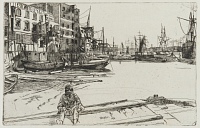Eagle Wharf | ||
| Number: | 50 | |
| Date: | 1859 | |
| Medium: | etching | |
| Size: | 140 x 217 mm | |
| Signed: | 'Whistler.' below centre | |
| Inscribed: | '1859.' at lower centre | |
| Set/Publication: | 'Thames Set', 1871 | |
| No. of States: | 1 | |
| Known impressions: | 73 | |
| Catalogues: | K.41; M.40; T.40; W.39 | |
| Impressions taken from this plate (73) | ||
KEYWORD
TITLE
'EAGLE WHARF', 'TYZAC, WHITELEY & Co.' and 'W. BROWN, SAIL MAKER, SHIP OWNER' (1859, Whistler). 2
'Tyzack Whiteley' (1861, V&A). 3
'Tyzack' (1862, Whistler). 4
'Eagle Wharf' (1871, Ellis & Green). 5
'Tyzack, Whitely, & Co.' (1874, Flemish Gallery). 6
'Tyzack Whiteley and Co.' (1874, Ralph Thomas, Jr (1840-1876)). 7
'Tyzack, Whiteley, & Co. (1886, Frederick Wedmore (1844-1921)). 8
'Tyzac Whiteley' (1889, Whistler). 9
'Tyzac Whiteley & Co.' (1890/1891, Whistler). 10
'Eagle Wharf' (1909, Howard Mansfield (1849-1938)).. 11
Variations on the sign 'TYZAC, WHITELEY & Co.', at upper left on the plate, alternate with the other title, also based on a sign board, 'EAGLE WHARF'.
'Eagle Wharf', as published in the 'Thames Set' in 1871, is the definitive title accepted by the majority of later cataloguers, from Mansfield on. It has the advantage of covering the wharf itself, which is central to the view, rather than a specific building.
2: Etched on the copper plate.
3: 1 January 1861, V&A Register of Prints, p. 32.
4: [May 1862/1864?], GUW #12745, p. 38.
5: A Series of Sixteen Etchings of Scenes on the Thames.
6: London Pall Mall 1874 (cat. no. 13).
7: Thomas 1874 (cat. no. 40).
8: Wedmore 1886 A (cat. no. 39).
9: List, 18 July 1889, GUW #13235.
10: List, [1890/1891], GUW #13236.
11: Mansfield 1909 (cat. no. 40).
DESCRIPTION
SITTER
12: Pall Mall Gazette, 1 January 1872, p. 11.
13: Lochnan, op. cit., p. 82.
SITE
Tyzac, Whiteley & Co. (who owned the building at left) were at 266-267 Wapping High Street, backing on to Baltic Wharf, and William Brown was a ship's chandler next door at No. 268. Tyzack, Whiteley & Co. were chain manufacturers based at the Anchor Works in North Shields; their partnership was dissolved, and the contents of the foundry auctioned, in 1868. 15
In his Thames etchings Whistler focussed on the area of Wapping from East London Lime Wharf, past the entrance to the Thames Tunnel, Tunnel Steam Packet Pier, Wapping Dock Stairs, Wheatsheaf Wharf (at No. 233 Wapping High Street), Shap's wharf, Execution Dock Stairs, Phoenix Wharf, the Thames Police Station (at No. 255), Aberdeen Steam Wharf (at No. 257), Baltic Wharf, Eagle Wharf (at No. 269), Hermitage Wharf (at No. 343), Watson's Wharf, and finally Hore's Wharf. 16
14: Another view, that looks nothing like Whistler's view, is seen in the photograph Black Eagle Wharf with the schooner Express of Alnmouth, , National Maritime Museum, repro ID H0042 in Portcities London at http://www.portcities.org.uk (accessed 2012).
15: Liverpool Mercury, 9 July 1868; Newcastle Courant, 10 July 1868. Thanks to Martin Hopkinson for this reference.
16: London Postal Directory, 1859.
DISCUSSION.
17: Dodgson 1922, pp. 6-7.
